B2B Vs. D2C – Managing B2B and DTC on Shopify Plus Together

eCommerce has evolved dramatically over the past decade.
Where companies once operated exclusively in either Direct-to-Consumer (DTC) or Business-to-Business (B2B) channels, today’s most successful brands are embracing hybrid eCommerce models that serve both markets simultaneously through their online store.
Direct to consumer commerce focuses on selling directly to end consumers through branded experiences, speed, convenience, and emotional connection. B2B commerce, on the other hand, involves selling to other companies with complex pricing logic structures, bulk orders, and relationship-driven transactions.
Companies are realizing that limiting themselves to a single channel (either D2C or B2B) is similar to letting go of interested customers.
However, managing both B2B and DTC on separate platforms creates is nightmare as you end up duplicating almost everything: product catalogs, inventory tracking, order management, and even customer accounts data.
This increases operational complexity, heightens the risk of human errors, conflicting data, and delays in order fulfillment.
Well, the best solution is managing B2B and D2C on Shopify Plus together as a single, same store.
Shopify Plus is an evolved platform with powerful multichannel selling capabilities and simplified workflows, helping you run both B2B and DTC operations side-by-side from one unified backend.
In this blog, we’ll explore the key differences between B2B Vs. D2C business models, the challenges of managing both, and how managing B2B and DTC on Shopify Plus bridges the gap by providing the key features for hybrid eCommerce success.
Let’s start.
Key Differences Between B2B and DTC Commerce
As you want to implement a B2B and DTC on Shopify Plus together, it’s better to start with understanding the fundamental differences between these two business models. Just so we leave no room for doubts later on.
B2B Vs. D2C – Customer Journey & Buying Process
The difference in B2B vs. DTC business models is mainly how customers make purchasing decisions.

B2B customers involves complex, multi-week/month buying cycles with multiple buyers and stakeholders (procurement managers to C-level executives), formal negotiations, and detailed vendor evaluations.

Meanwhile, D2C customers operate on fast-paced decisions driven by emotional triggers where customers can discover, research, and purchase within minutes.
B2B Vs. D2C – Pricing Structures
The next difference lies in pricing logic and custom pricing structures.

B2B uses complex tiered pricing with volume pricing discounts, preferential rates for long-term contracts, and custom pricing negotiations for different customer tiers, whereas D2C maintains consistent, transparent pricing with standardized rates, promotional offers, and loyalty benefits through targeted discounts rather than individual negotiations.
B2B Vs. D2C – Order Volume & Fulfillment Complexity
The scale and frequency of orders differ dramatically between these models.

B2B customers feature larger quantities, less frequent orders with higher values, recurring purchases, and predictable bulk orders patterns for better inventory planning. On the other hand, selling to DTC customers involves smaller, more frequent orders based on immediate needs with focus on increasing frequency through upselling and engaging customer experience.
Pro Tip: Having trouble finding the right template or just short on time? Use B2B Vs. D2C to generate a unique 6-pager design tailored to your needs.
B2B Vs. D2C – Checkout Experience & Payment Terms
Another differing factor is the checkout experience and payment terms.

To B2B customers, you need to provide sophisticated account portals with custom pricing access, order history, reorder functionality, and multiple buyers’ permission levels (view-only to full purchasing authority). Meanwhile, for DTC customers, you need to focus on individual personalization with product recommendations, tailored content, and loyalty benefits alongside guest checkout options.
B2B Vs. D2C – User Accounts & Personalization
Account management reflects the relationship complexity of each model.

B2B provides sophisticated account portals with custom pricing access, order history, reorder functionality, and multi-user permission levels (view-only to full purchasing authority), while D2C focuses on individual personalization with product recommendations, tailored content, and loyalty benefits alongside guest checkout options.
B2B Vs. D2C – Marketing & Customer Engagement
The approach to customer acquisition and retention varies significantly between these models.

B2B relies on relationship-building through account-based marketing, educational content, case studies, personalized outreach, trade shows, and professional networks, whereas D2C uses mass reach strategies via social media advertising, influencer partnerships, brand storytelling, and viral growth through user-generated content and community building.
Challenges of Managing B2B and D2C Business Models Seperately
Many business owners choose to operate B2B and DTC channels separately for their brand.
However, that creates certain operational challenges that arise over time, ultimately limiting growth potential and creating unnecessary complexity for companies attempting to serve both markets through multichannel selling.
Case 1 – No Unified Insights into Customer Behaviour
When B2B and DTC operations run on different platforms, you may lose the ability to gain unified insights into customer behavior, inventory performance, and overall business health. In short, separating B2B and D2C offerings by platforms would mean missing opportunities for tracking customer behaviour and providing personalized experiences.
Case 2 – Increased Costs from Platform Duplication
When you choose to maintain two different eCommerce platforms for B2B and D2C offerings, it doubles development costs, security updates, and ongoing maintenance requirements; AKA an extra cost for everything.
Each platform requires separate integrations, customizations, and technical expertise, significantly increasing operational overhead.
So, you’re essentially paying twice for everything, including developer hours, platform fees, and plugin licenses.
Case 3 – Operational Inefficiencies Across Systems
Running B2B and DTC operations on separate platforms leads to serious backend issues that might create chaos and costly errors.
And this makes it hard to maintain the right stock levels, requires multiple system changes for pricing updates, and fulfillment processes become unnecessarily complex too.
Case 4 – Inconsistent Customer Experiences
When customers interact with your brand through different channels, inconsistent experiences can damage brand perception and customer loyalty. This fragmentation is particularly problematic as the lines between B2B customers and DTC customers continue to blur.
;
So yeah, we saw how managing B2B and DTC separately can quickly spiral into higher costs, clunky operations, and a fragmented customer experience.
Running B2B and DTC on Shopify Plus actually gets this problem and offers pretty solid hybrid eCommerce solution to bring both sides of your business under one store roof.
Let’s finally understand how Shopify bridges that gap.
# How Managing B2B and DTC on Shopify Plus Helps Bridge the Gap?
Shopify Plus provides flexibility in structuring your B2B and DTC experiences.
You can operate both your business models from the same store with custom themes and navigation, or create a dedicated store for wholesale customers.
Let’s check what Shopify Plus brings to the table to help manage B2B and D2C operations together.
1. Unified Storefront or Dedicated B2B Channel
Shopify launched a native solution, named the “B2B Features on Shopify”, which allows you to manage both customer types within a single storefront while maintaining different experiences.
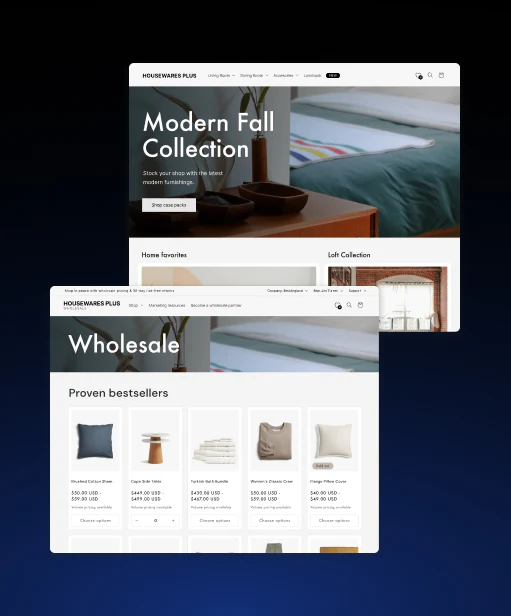
These B2B features make Shopify Plus, a unified platform where your wholesale operations and direct-to-consumer sales can coexist seamlessly, with customer accounts automatically receiving the appropriate experience based on their classification.
So, whether you choose a single store approach or separate storefronts for B2B and D2C operations, Shopify admin provides centralized management with its B2B features.

Managing B2B and D2C on Shopify Plus allows your business to expand and support wholesale customers without needing separate branding or workflows.
Also, you’ll have the same backend infrastructure for inventory management and order processing.
Coming to the part of inventory, Shopify Plus seamlessly integrates with Shopify POS systems, enabling you to manage in-person sales alongside their online B2B and DTC operations.
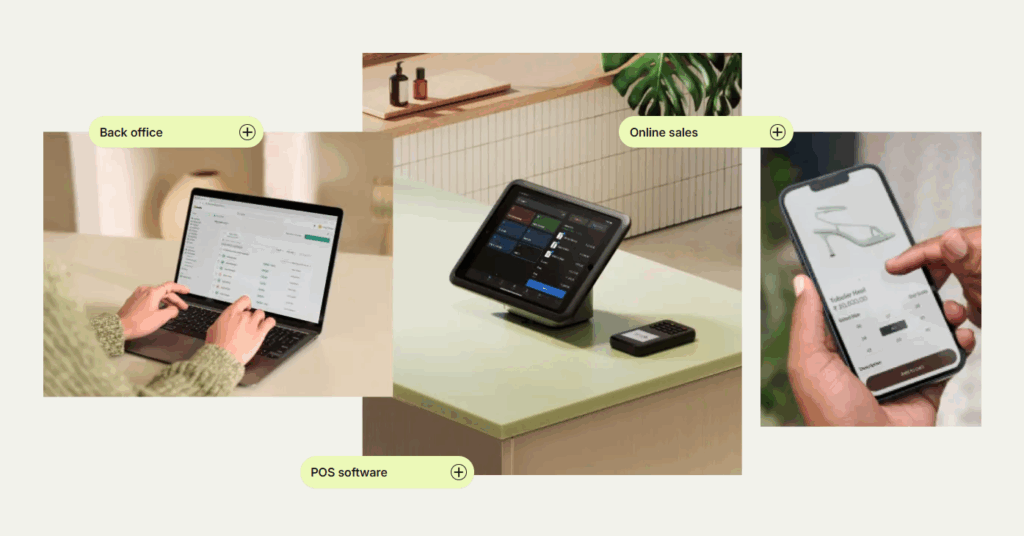
This creates a truly unified commerce experience across all touchpoints, from online storefronts to physical retail locations without needing third party apps.
And with such flexible offerings, running both B2B and DTC on the Shopify Plus backend means less complexity, more control, and faster execution. Instead of juggling between platforms, you get a centralized dashboard to streamline operations, unify your brand experience, and reduce technical debt.
Also, with Shopify’s composable architecture and constant updates, you get faster time to market and manage everything from wholesale pricing and product bundles to custom discounts and automated workflows, all in one place.
Plus, with access to over 8,000 third party apps, you can extend functionality as needed without ever leaving your ecosystem.
2. Customer-Specific Pricing & Tiered Discounts
Running B2B and DTC on Shopify Plus brings in access to a sophisticated pricing logic functionality that handles complex B2B pricing structures while maintaining standard DTC pricing models.
The platform supports multiple pricing strategies simultaneously through its Shopify multichannel strategy, and here’s a detailed explanation for it.
◻️ Dynamic Quantity Breaks and Tiered Pricing
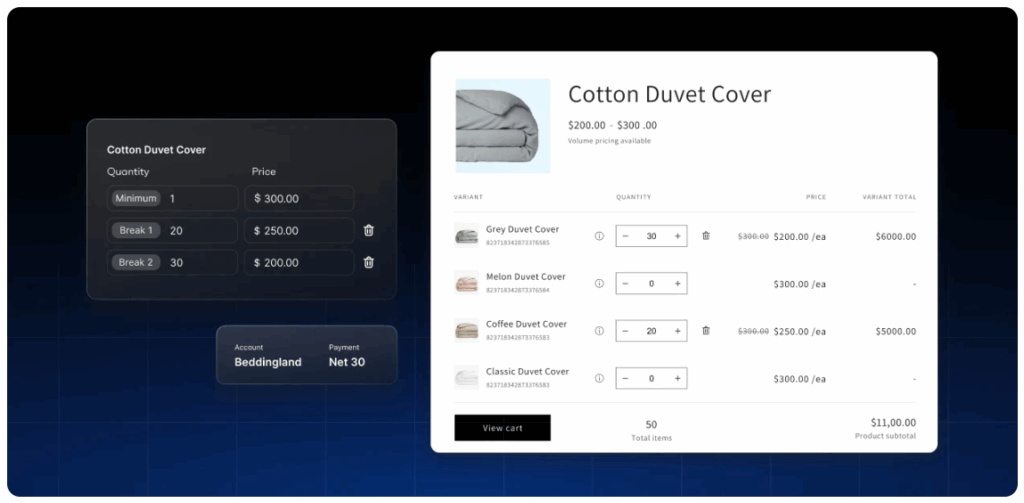
As you can see in the interface, when managing B2B and D2C on Shopify Plus, you can set up multiple pricing tiers within a single product.
For example, a Cotton Duvet Cover can display different pricing structures and custom discounts:
- Minimum quantities: Set minimum order requirements (e.g., minimum 1 unit)
- Volume breaks: Configure multiple price breaks (Break 1: 20 units at $250.00, Break 2: 30 units at $200.00)
- Visual pricing display: Customers can see minimum order quantities, quantity-based pricing with clear unit costs and total calculations and company locations.
This helps you cater to every customer by curating an end-to-end buying experience with custom pricing, quantity rules, and payment terms. Also, the interface is easy to use, which is a plus point for companies with multiple buyers, locations, and purchase permissions.
◻️ Real-Time Price Calculations
With the custom pricing set up in backend, the system automatically calculates pricing based on quantity selections, showing customers exactly how bulk ordering affects their total cost.
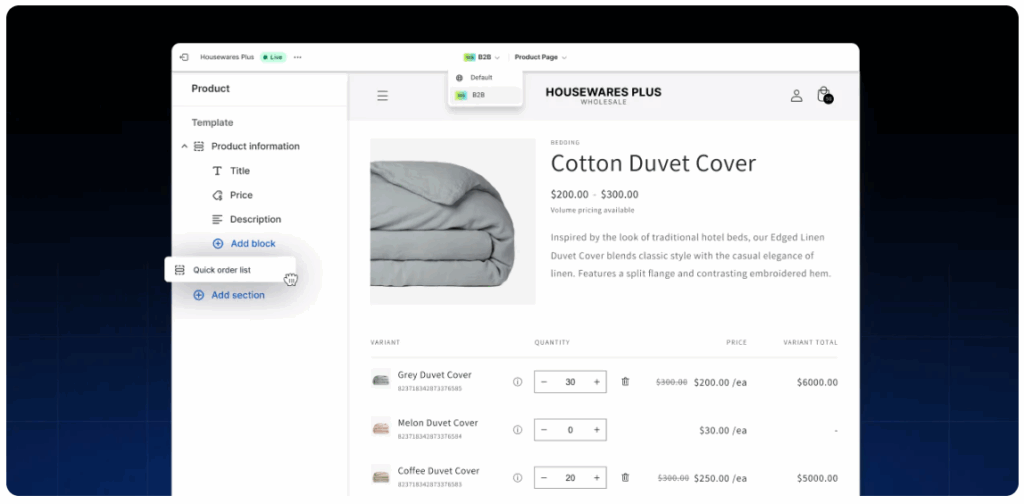
This transparency helps B2B customers understand the value of larger orders while maintaining clarity for DTC purchases.
◻️ Customer-Specific Custom Catalogs and Company Profiles
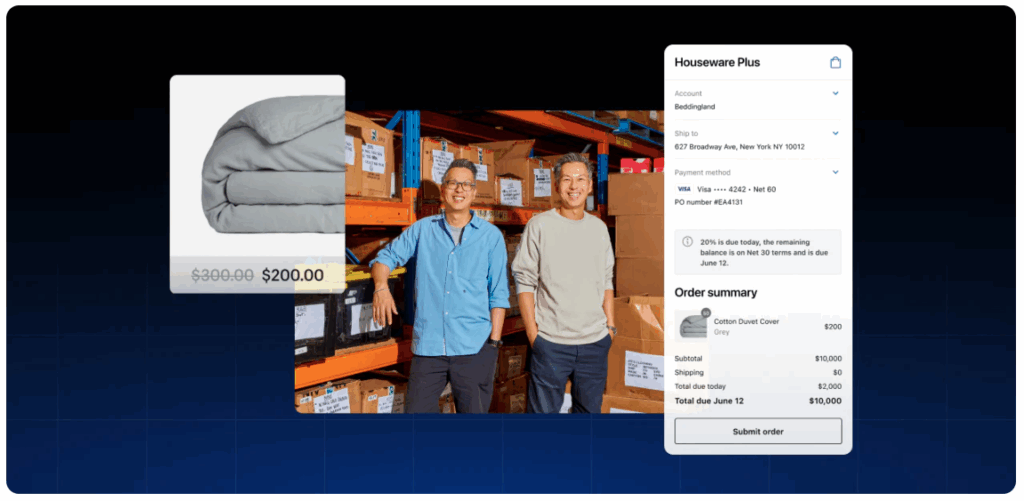
Running B2B and DTC on Shopify Plus allow to set custom pricing at the company level, with price lists automatically applied to company profiles and their multiple buyers. Here are the provision areas for customer specific catalogs:
- Curate product catalogs: Show different product selections to different customer segments
- Apply custom pricing: Display personalized pricing based on customer agreements
- Manage multiple buyers: Support complex organizational structures with different access levels
This is beneficial in a way that it you can show the right products, pricing, and permissions to the right buyers; automatically.
Just that you need to set up custom price lists tied to specific company profiles, so each business sees their negotiated rates and curated catalog without manual intervention. Plus, support multiple buyers per company with role-based access to streamline complex organizational structures.
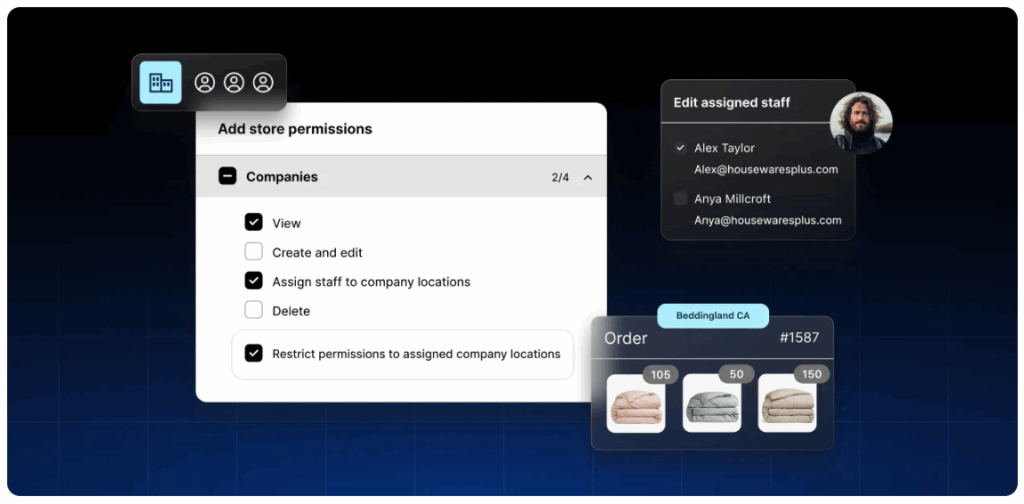
This not only enhances customer satisfaction but also boosts efficiency by minimizing order errors, manual adjustments, and support overhead.
◻️ Flexible Payment Net Terms Integration
Next, running B2B and DTC on Shopify Plus together makes it easy to manage B2B and DTC payments from a single platform serving a blended store.
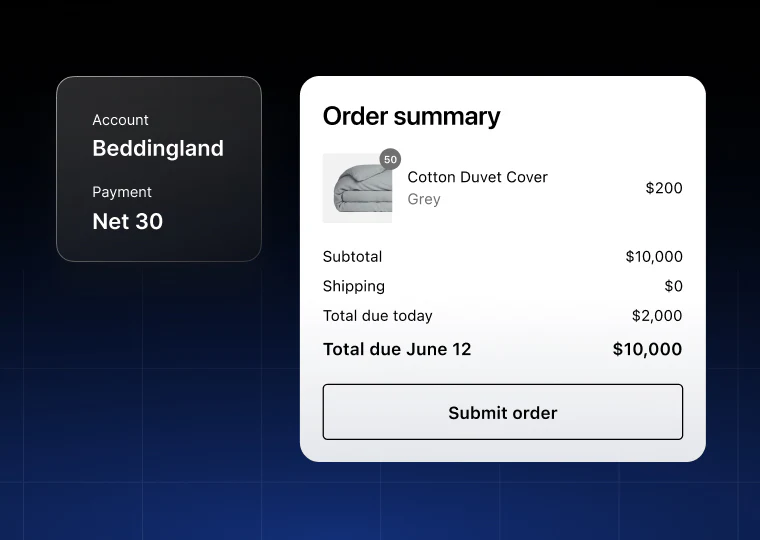
The pricing system, when running B2B and DTC on Shopify Plus, integrates seamlessly with flexible payment terms, supporting Net 30 payment options and invoice-based transactions for B2B customers while maintaining standard payment processing for DTC sales.
This flexibility allows you to meet the expectations of enterprise buyers while still providing instant, frictionless payments for everyday customers. Also, it simplifies accounting, improves cash flow management, and eliminates the need to send invoices physically.
And that keeps your customer experience smooth on both sides of the business.
◻️ Advanced Discount Rules
Also, managing B2B and DTC on Shopify Plus supports complex discount structures for your B2B and D2C offerings, including percentage discounts, fixed amount reductions, and buy-X-get-Y promotions that can be added for specific customer segments or purchase behaviors.
And it will all be managed from single interface for pricing logic.

And with that, you can target specific customer segments and purchasing behaviors with precision.
No more juggling different systems or duplicating discount logic.
From volume-based incentives for wholesale clients to limited-time promos for retail shoppers, everything is managed centrally; saving time, reducing errors, and maximizing impact.
C. Custom Checkout Flows
Next, you know how important checkout is for both B2B and D2C customers.
Your D2C customer would need a standard checkout, and B2B customers would need a checkout that fits with their internal purchase processing systems. And you surely need better functionality to achieve that under a single storefront.

Managing B2B and DTC on Shopify Plus together provide flexible checkout experiences that you can customize to different customer types and business requirements:
◻️ B2B Checkout Features
- Net Payment Terms: Support for Net 30, Net 60, and other flexible payment arrangements.
- Purchase Order Processing (PO): Integration with corporate procurement systems.
- Tax Exemptions: Automatic handling of tax-exempt business customers.
- Multi-currency Support: International wholesale operations with localized pricing and multiple currencies.
- Draft Orders: Sales reps can create custom orders with special pricing or terms.
◻️ DTC Checkout Optimization
- Express Payment Options: Quick checkout with digital wallets and saved payment methods.
- Subscription Services: Recurring billing and subscription management.
- Guest Checkout: Streamlined purchasing for one-time buyers.
- Mobile Optimization: Responsive checkout flows optimized for mobile devices.
And all of it is unified under single shopping cart when running B2B and DTC on Shopify Plus.
This, Shopify’s unified shopping cart includes Split Shipping in checkout, giving customers control over the delivery of each item in an order to meet the potential constraints of a shopping journey.
This feature is particularly valuable for both you and your B2B customers who may need items delivered to multiple company locations while helping with seamless DTC management.
D. Account & Permissions Management
Managing B2B and DTC on Shopify Plus offers enterprise-grade account and user permissions management, making it easy to serve both B2B and DTC customers from a unified platform, without sacrificing control or personalization over Shopify Plus store design.
Here’s how it helps your business run smarter and more efficiently:
◻️ Company Profiles with Approval Workflows
At first, managing B2B and DTC on Shopify Plus allows a store setup with detailed company profiles that mirror real-life B2B hierarchies, including multiple buyers, custom pricing, and product access based on contracts. With built-in approval workflows with B2B and DTC on Shopify.
Plus, you can ensure every order follows your client’s internal procurement rules, reducing back-and-forth and accelerating order processing. This helps speed up large purchase cycles, minimizes human error, and builds trust with enterprise customers.
◻️ Role-based Permissions
Next, it offers advanced permission systems allow businesses to control what different users can see and do within the platform.
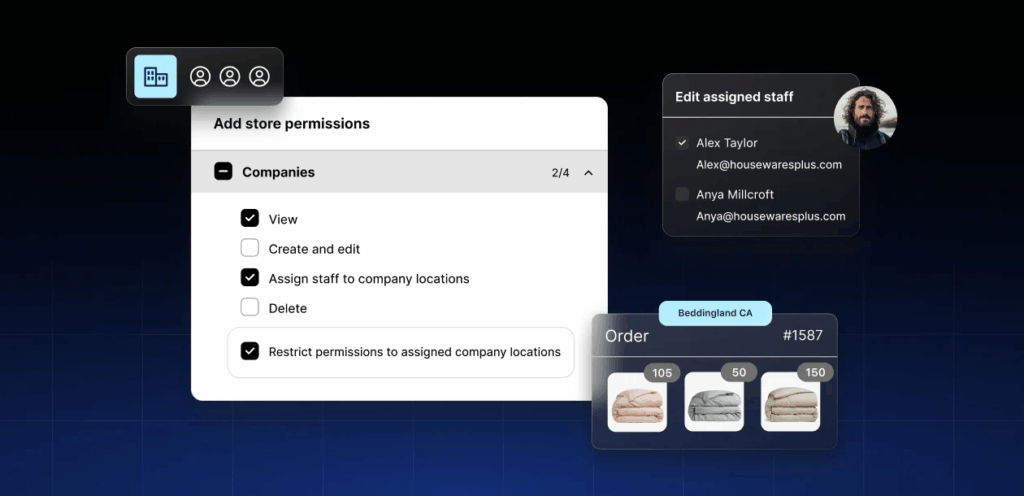
Sales reps can be given specific access to their assigned accounts, while buyers can have different permission levels based on their role within their organization.
◻️ Self-serve Portals & Guest Checkouts
To maintain checkout experience for both B2B customers, it provides access to comprehensive self-service portals with order history, reorder functionality, and account management tools. Meanwhile, DTC customers can choose between creating accounts for personalized experiences or using quick guest checkout options.
◻️ Approval Workflows
The platform supports complex approval processes for B2B purchases, including spending limits, multi-level approvals, and purchase order requirements that integrate with existing corporate procurement procedures.
Overall, managing B2B and DTC on Shopify Plus’s advanced account and permission management lets you mirror real-world business hierarchies with precision.
By setting role-based access, company profiles, and approval workflows, you ensure the right people see the right data.
E. Headless Commerce for Greater Flexibility
Next, if you choose headless commerce for greater flexibility of your B2B and D2C operations, Shopify Plus helps there as well.

Shopify Hydrogen, which is Shopify’s React-based framework to for headless commerce development with all the tooling needed for production-ready storefronts. It comes with built-in hosting and Shopify’s APIs.
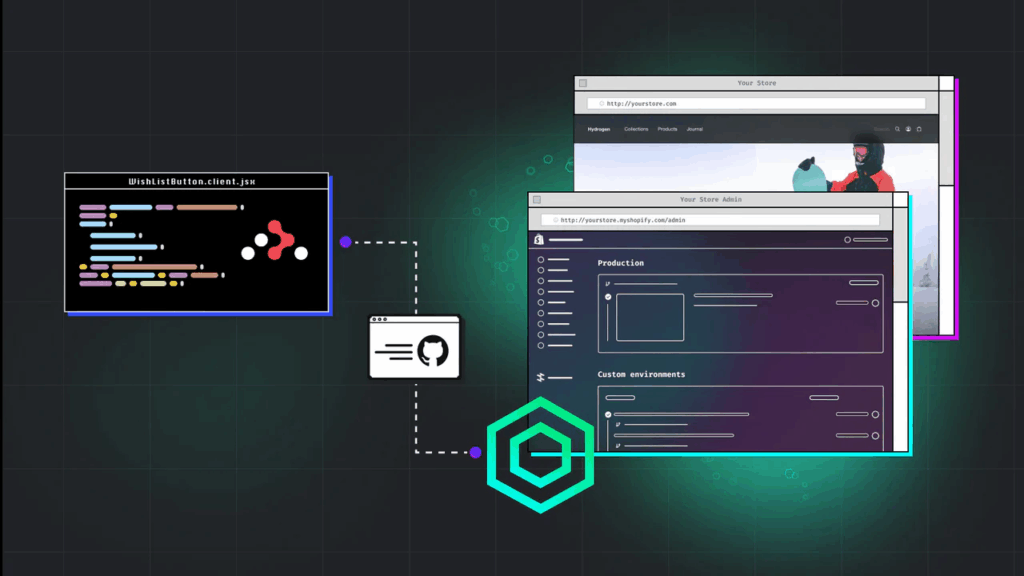
It is especially designed to build custom storefronts with speed and efficiency, providing developers with pre-built components and utilities to create fast, seamless shopping experience for both B2B and D2C offerings.
Headless architecture enables you to create completely different front-end experiences for B2B and DTC customers while maintaining a unified backend.
This allows for:
- Custom B2B portals with specialized functionality
- Consumer-focused DTC experiences optimized for engagement
- Mobile apps with platform-specific features
- Integration with existing enterprise systems
Also, it works with API-first approach. So, you will have the flexibility to build custom hybrid eCommerce solutions that perfectly match their business requirements, whether creating specialized B2B tools or innovative DTC experiences.
Moreover, you get power by integrating any tech stack of your choice to maintain an easy-to-use admin.
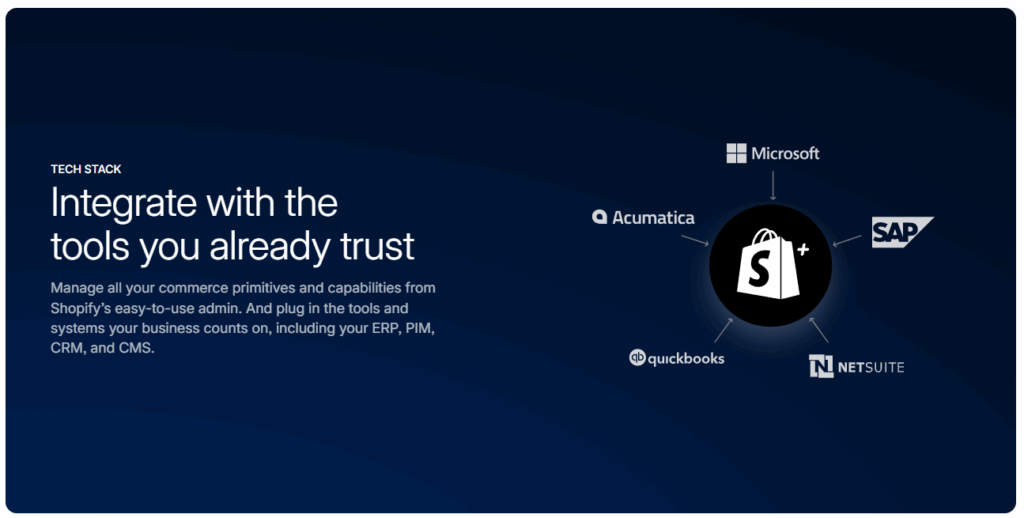
F. Back-End Integrations & Automation
When running B2B and D2C on Shopify Plus, you get an access to unified backend where you can allocate resources, track performance, and implement strategies across different stores without switching between accounts. This streamlined approach helps to save time and reduce complexity.
Here’s an idea on supported integrations and automations when managing B2B and D2C on Shopify Plus together.
◻️ Enterprise System Integration
Shopify Plus integrates seamlessly with essential business systems:
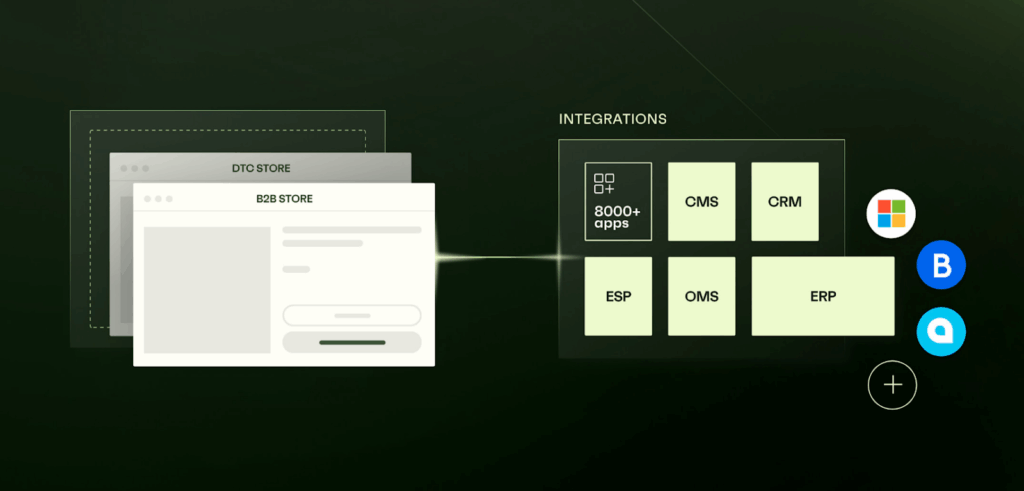
- ERPs: Microsoft Dynamics, SAP, NetSuite for comprehensive business management
- CRMs: Salesforce, HubSpot for customer relationship management
- PIMs: Product Information Management systems for catalog management
- Accounting: QuickBooks, Xero for financial operations
◻️ Shopify Flow for Workflow Automation
When you run B2B and D2C on Shopify Plus and want to automate workflow, you get access to Shopify flow. This is a Shopify-developed tool that enables complex workflow automation to streamline processes across both B2B and DTC operations.
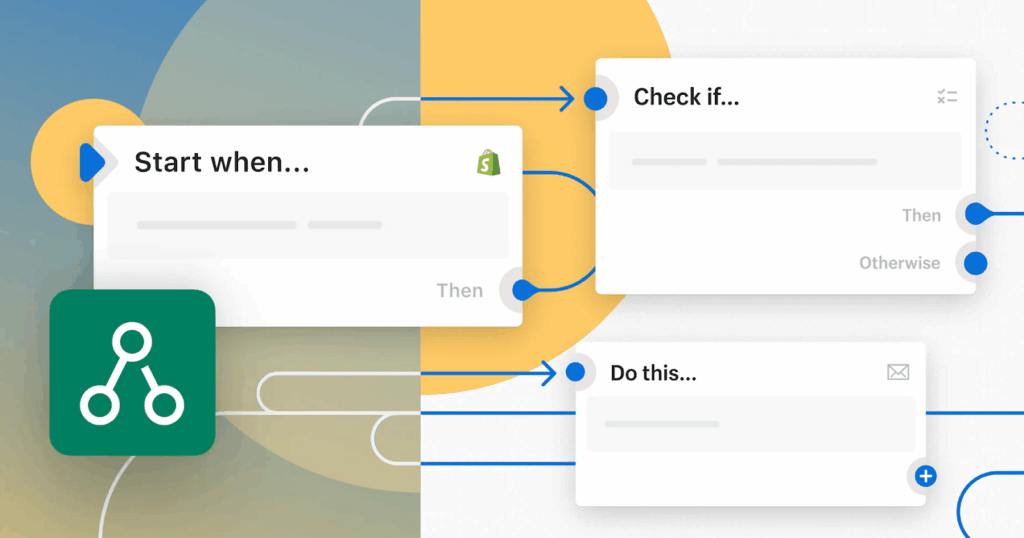
Overall, it can help automate in areas including:
- Automated Customer Segmentation: Classify customers based on purchase behavior and order history
- Inventory Management: Automatic updates across multiple company locations and channels
- Order Processing: Streamlined fulfillment workflows for different customer types
- Customer Communication: Automated notifications and follow-ups tailored to customer segments
◻️ Data Synchronization
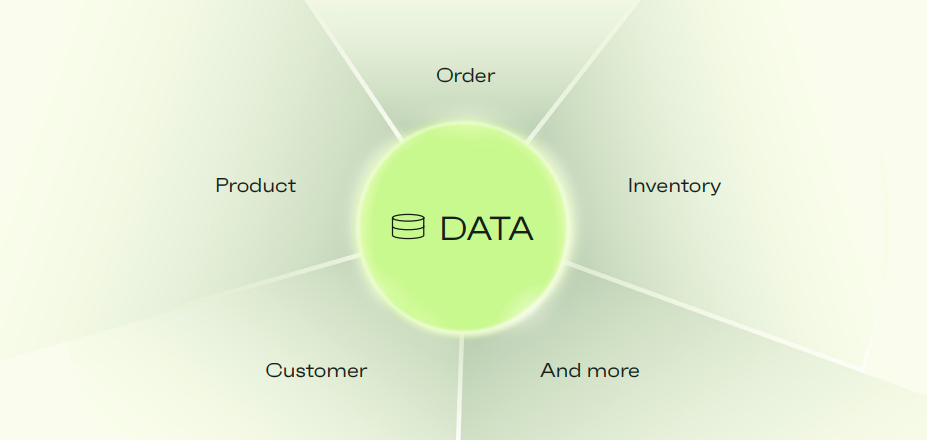
Shopify Plus, as a platform ensures data consistency across all touchpoints, preventing discrepancies between B2B and DTC operations. When you choose Plus to merge your B2B and D2C operations under single dashboard, your store data will be synchronized in real time.
Be it your product data, order data, inventory data, customer data, or more.
And that means inventory levels, pricing updates, and customer information remain accurate across all channels.
◻️ Scalable Architecture
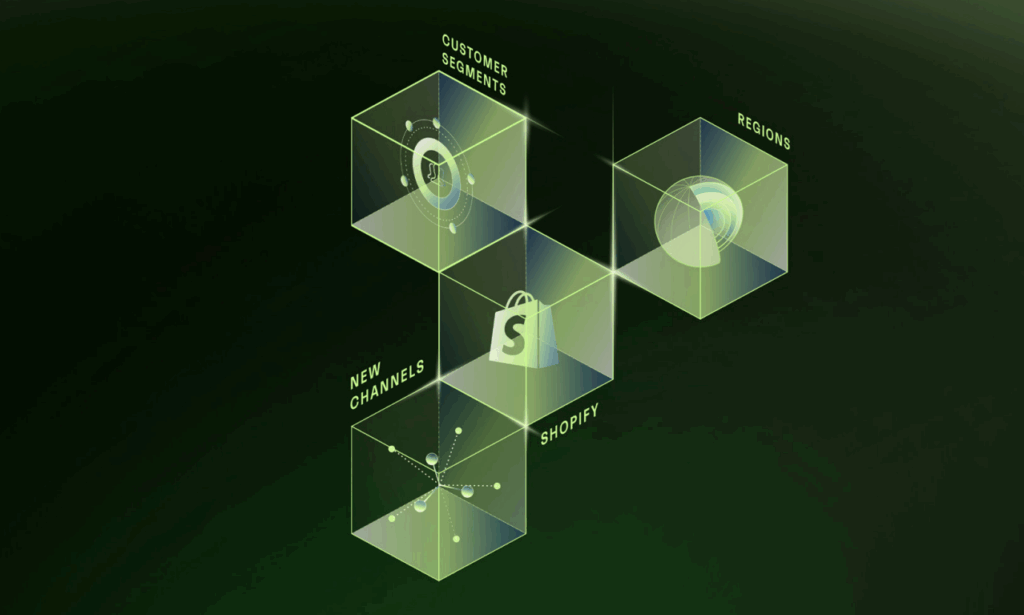
Also, with running B2B and B2C on Shopify Plus, you’ll get built-in solutions for wholesale pricing, net payment terms, and quick bulk ordering.
Shopify Plus allows merchants to run both B2B and B2C from a dedicated expansion store. This removes the need for custom-built wholesale portals, providing a scalable foundation that grows with business needs.
;
And that shares on how effortlessly Shopify Plus helps you manage your B2B and D2C operations at a time.
# Key Advantages of Managing B2B and DTC on Shopify Plus Together
The integration of your B2B and DTC commerce operations on Shopify Plus delivers several measurable benefits:
1. Operational Efficiency
- Reduced Complexity: Eliminate the need for separate systems and their associated maintenance costs.
- Unified Inventory: Real-time inventory management across all channels and customer types.
- Streamlined Processes: Consistent workflows reduce training time and operational overhead.
- Centralized Management: Single dashboard (Shopify admin) for managing all customer segments and sales channels.
2. Enhanced Customer Experience
- Consistent Branding: Unified brand experience across all touchpoints.
- Reliable Service: Proven platform reliability and performance.
- Flexible Purchasing: Multiple buying options tailored to customer preferences.
- Seamless Transitions: Customers can easily move between B2B and DTC purchases as needed.
3. Business Intelligence
- Unified Analytics: Comprehensive insights from all customer segments and channels.
- Performance Tracking: Compare and optimize the performance of the Shopify Plus store across different business models.
- Customer Insights: Better understanding of customer behavior across all touchpoints.
- Revenue Optimization: Identify opportunities to maximize revenue from both channels.
And this comprehensive list of benefits of managing B2B and DTC on Shopify Plus together show that you don’t need to choose between succeeding on B2B or DTC.
When you have right platform architecture, you’ll eventually get the power to grow in both segments.
# A Look At Brands Successfully Managing B2B and DTC on Shopify Plus
A unified approach where you manage B2B and DTC on Shopify Plus together is not just a vision.
Many brands are already strategically using B2B and DTC on Shopify Plus to power both their B2B and direct-to-consumer operations.
And their success stories demonstrate how a single platform can eliminate the complexity of managing multiple systems while delivering exceptional experiences across all customer touchpoints.
And we will be dissecting success for two brands.
1. Brooklinen: From DTC Pioneer to B2B Powerhouse
Brooklinen started as a direct-to-consumer bedding brand has evolved into a sophisticated operation serving both individual customers and major US hotel chains.
Brooklinen’s journey illustrates the natural progression many brands experience as they expand their market reach.
The Challenge: Brooklinen was struggling with manual, ad-hoc B2B sales processes that were clearly unsustainable as demand from hotel partners grew. Their existing approach lacked the scalability needed to serve enterprise customers effectively while maintaining their successful DTC operations.
The Shopify Plus Solution: Rather than implementing a separate B2B platform, Brooklinen chose to extend their existing infrastructure to manage B2B and D2C on Shopify Plus together. This decision allowed them to maintain brand consistency while creating distinct buying experiences for different customer segments.
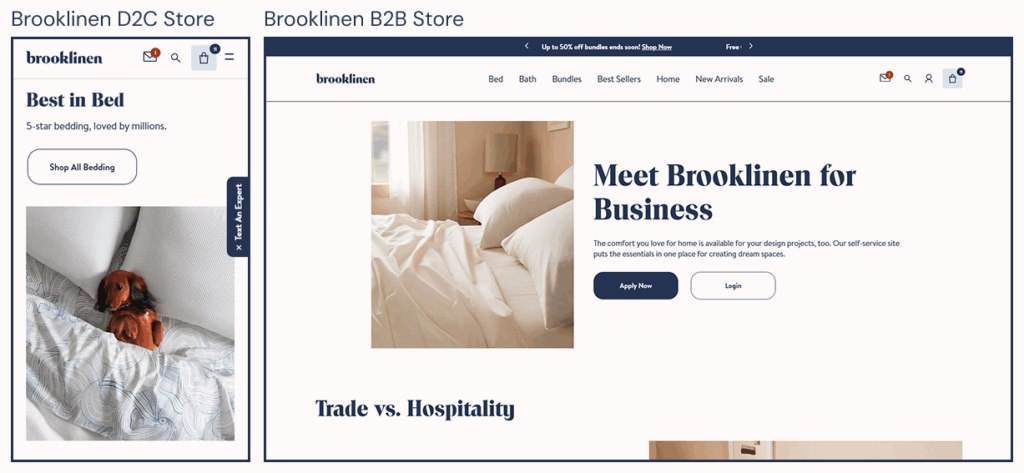
Results They Achived →
- 80% less time spent on manual tasks, freeing the team to focus on customer relationships
- Full self-service access for B2B clients to handle orders and account management
- A smooth, unified experience for all buyers
- No need to manage multiple platforms as they scale
2. Dermalogica: Mastering Complex B2B While Maintaining Consumer Appeal
Dermalogica’s 35+ year journey in skincare education and products presented unique challenges when their custom-built B2B platform couldn’t keep pace with their growing needs. Their solution demonstrates how brands can maintain complex B2B requirements while delivering the intuitive experiences customers expect.
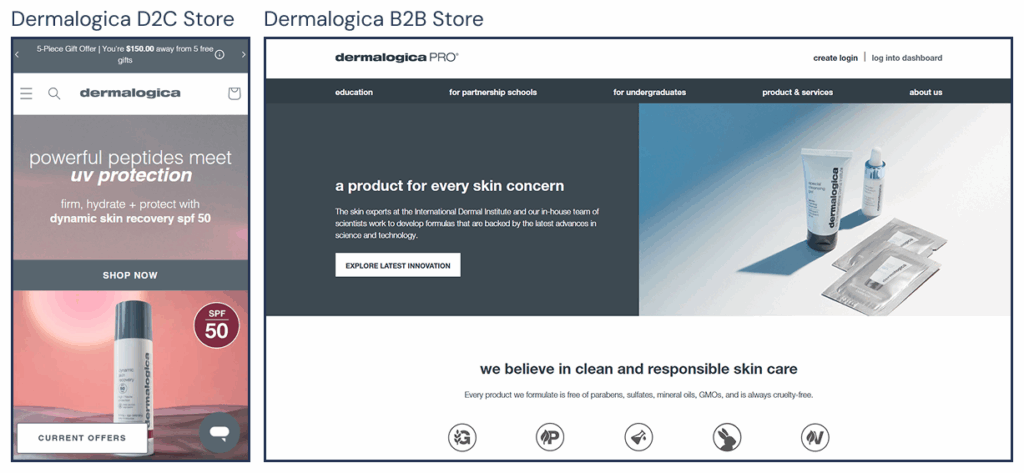
The Transformation: Moving from a custom platform to managing B2B and D2C on Shopify Plus together, Dermalogica Canada became the first market within their organization to adopt this approach, serving as a proof of concept for global expansion.
Results They Achived →
- 75% of B2B buyers now rate their shopping experience 4 out of 5 or higher
- 23% boost in conversion rates
- 338% spike in reorder frequency
- A flexible, modern tech stack that evolves with Shopify
Managing B2B and DTC on Shopify Plus Together!
If you’re an eCommerce business currently managing separate B2B and DTC systems or looking to build a separate system for one of your business operations, the transition to Shopify Plus is all in one solution to simplify operations while expanding capabilities.
Also, migrating to Shopify Plus is easy & smooth with the availability of the best migration tools and an extensive partner ecosystem.
Now, see, the question isn’t whether unified commerce will become the standard.
It’s whether your business will be among the early adopters who gain competitive advantages, or if you’ll be forced to catch up later when the market demands it.
The future of B2B and D2C commerce is unified, and that future is available today with Shopify Plus.
# Get Consulted On How to Manage B2B and DTC on Shopify Plus Together
Making your operations seamless by unifying B2B and DTC requires more than just the right platform.
You’ll need right development partner with expertise, strategic planning, for flowless execution.
And we, Aureate Labs, can help you with it.
We’re Shopify Plus Partners with over 13 years of experience in eCommerce development. Until now, we’ve helped countless businesses successfully merge their B2B and DTC operations on Shopify Plus. Our deep understanding of both the technical capabilities and business challenges involved in unified commerce makes us the ideal partner for your requirements.
Book a free appointment with out Shopify Plus expert here !!
We can guide you on where to start. 🙂






Post a Comment
Got a question? Have a feedback? Please feel free to leave your ideas, opinions, and questions in the comments section of our post! ❤️